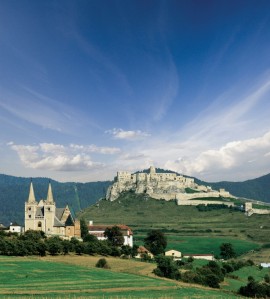UNESCO sites in Slovakia

UNESCO sites in Slovakia
Properties inscribed on the World Heritage List
The 1972 Convention concerning the Protection of the World Cultural and Natural Heritage developed from the merging of two separate movements: the first focusing on the preservation of cultural sites, and the other dealing with the conservation of nature.
The World Heritage Committee consists of representatives from 21 of the States Parties to the Convention and is responsible for the implementation of the World Heritage Convention. It has the final say on whether a property is inscribed on the World Heritage List.
Slovakia’s date of ratification of the Convention is Wednesday, March 31, 1993.
Cultural properties:
The castle of Spis (Spišské Podhradie, Spišská Kapitula and Zehra) - 1993 a national cultural monument, the biggest medieval castle in central Europe
Banska Stiavnica – 1993 - and technical memorabilia in its environment - it represents the mining tradition in Slovakia
Vlkolinec – 1993 - a reservation of folk architecture
Bardejov – 2000 – eastern Slovakian gothic town with very well-preserved historic town castle complex
Natural properties:
- Jaskyňa Domica 1995
- Gombasecká jaskyňa 1995
- Jasovská jaskyňa 1995
- Ochtinská aragonitová jaskyňa 1995
- Dobšinská ľadová jaskyňa 2000
Cultural properties on the UNESCO World Heritage List in Slovakia
The castle of Spis (Spišské Podhradie, Spišská Kapitula and Zehra church) it is a unique historical complex. The castle of Spis is the biggest medieval castle in central Europe (12th century). Spisske Podhradie it is a departure point for the castle of Spis (origin in 12th century) and Spisska Kapitula is a town reservation, It arose as an independent church community at St.Martin's hill; it is accessible from the village of Spisske Podhradie. An early gothic church of the Holy Ghost in Zehra is from 14th century. Almost the whole interior is covered with frescos from 14th and 15th century. The most interesting are the images and scenes reminding The Bible of poor, according what they would remember the most important truths in their religion.
Banska Stiavnica it represents the mining tradition in Slovakia. It is a town reservation with a wealth of historic, cultural, artistic and technical interest. Banská Stiavnica started with the year 1238 when it was bestowed the privileges of a royal town. From the very beginning the town had been closely connected with mining and even its coat-of-arms, producing both silver and gold. In 1762 it became the seat of the Banska Academy. This school was the first mining college in Europe.
Vlkolinec is a reservation of folk architecture, an under-mountain village situated in the beautiful surroundings in the foothills of the Velka Fatra (718 m above sea level). The unique think about Vlkolinec is its wooden architecture which presents about 40 wooden houses from 16th to 19th century. It was first mentioned in 1376.
Bardejov - The earliest written record dates back to 13th century. In the 15th century, Bardejov reached the pinnacle of its economic development, not only due to the overall advanced level of the local trades, but specifically due to advances in linen. The town with spas, mills, breweries, brickfields was a centre of business and crafts. The most precious monuments are the monumental St.Egidius Church from 14th century, Town Hall built in 1511, gothic burgher's houses, St.Francisians church, Greek-catholic church, small Jewish quarter around a fine 18th-century synagogue.
Natural properties on the UNESCO World Heritage List in Slovakia
Caves of Aggtelek Karst and Slovak Karst were inscribed on the Unesco list in 1995 and extended in 2000 to Dobsinska ice cave.
There are about 3800 caves in Slovakia. Only 12 of them are opened for the public, from which 3 caves of Slovak Karst (Domica, Gombasecká cave, Jasovská cave), Caves of Aggtelek Karst and Dobsinska ice cave are inscribed on the Unesco World Hiretage list.
The Caves of Aggtelek and Slovak Karst territory extends over a total area of 55,800ha and topographically comprises limestone plateaus dissected by deep river valleys. The territory is characterised by a fully developed karst landscape, of which dolines are the most typical surface landform. These have developed through solution and are, on average, 100m wide and 20m deep.
Other surface phenomena include sink holes and karren fields. This is the most extensively explored karsts area in Europe, and a total of 712 have so far been identified. Many of the younger caves which have formed at the plateau edges, such as Krasnohorska and Gombasecka, occur on several levels and contain dripstone decorations. The most notable of these is the Baradla-Domica cave system which is 21 km long and connects Hungary with Slovakia. It has a cavern capable of holding 1,000 people, a 13m long stalactite and the autochthonous underground river Styx. These caves are also noted for having the world’s highest stalagmite (32.7m), aragonite and sinter formations and an ice filled abyss, which considering the territory’s height above sea-level, is a unique phenomena for central Europe. All these karst landforms are the result of long term geomorphological processes typical of this temperate climatic zone. Hydrological conditions are characterized by a lack of surface streams, except between mountain basins, and the complex circulation of underground water.
The flora is representative of both Pannonian and Carpathian elements, giving rise to a unique biotope arises where two floral sectors overlap, and consequently many rare endemics can be found throughout the territory. Approximately 70% of the territory consists of deciduous woodland. The fauna is characteristic of steppe/forest-steppe habitats. The caves are noted for their diverse and abundant fauna.
Source: www.slovakiatravels.com
More info: >www.slovakia.travel
Photo:
Archív VÚC Banská Bystrica
www.slovakia.travel - Alexander Vojček
Quick navigation
Slovaks on the map
Slovakia 2011

Let's talk
Exchange rates
Most read - SK Forum
| 25456x | Chcete lietať KE -… |
|---|---|
| 19691x | CESTA DOMOV (krizova) |
| 17034x | Slovaks in London wanted… |
| 12555x | Free Intercultural Communication… |
| 12091x | Cesta z UK na SR tento… |












